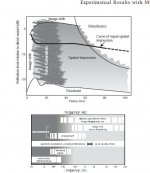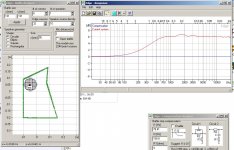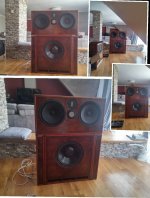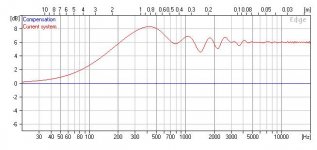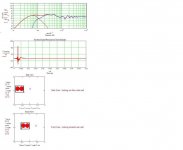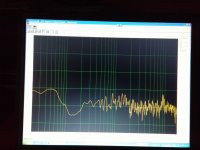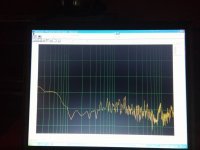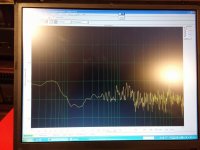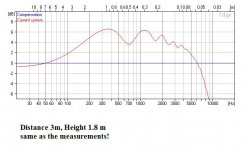LOL!Guess you haven't heard a good one, Scott. I can understand your opinion if you haven't. Most people don't know how to do OB right. Choice of driver, baffle size and crossover are important and different enough from box speakers that many people don't get it right. I've heard more OB speakers done wrong than box speakers.
Done right, they sound very good indeed.
Hi Pano,
Your guess is 100% correct, so I guess it's okay to guess
I have listened to several done by DIY'ers, and a few done by a professional
engineer. The DIY attempts were DREADFUL, the pro guy's units were much better, but still, all I hear are 1/2 notes in the bass. No attack at all compared to what I listen to (ppsl). I guess I am always aware of the bass cancellation that invariably takes place due to the wrap around. Ya see, this is why I do not "get" this cult following. Given the immediate sacrifice, the follower says, "oh that's okay that we are pursuing an inferior approach because it will save me the time by not building those {nasty} boxes". The OB enthusiast always calls them speaker "boxes". And believe me, a lousy box is evil indeed. So, continuing, the follower decides that dealing with the wrap around by EQ. is just a fine and dandy deal because we are NOT going to be concerned with the increase in modulation distortion as a result. Well, that's enough for now. Don't EVEN get me started how nice the echoes are, from behind those planks.
Pano, it's nice to hear from you. I hope you are very happy in your new digs. In your tribute, I am working on a super high-tech mod of our old friend,
"The Voice of the Theatre" (pronounced with an English accent, of course !
QUADS, simply Lovely !
The best QUAD set up I ever heard was when they were used in pairs per side, as a devoted wide band midrange. Infinite baffle bass for the low frequencies,
a really nice ribbon for the highs. The ENTIRE wall behind the speakers was covered in double thick acoustic material. An HQD on steroids, perhaps ?
QUADS are simply lovely
The Quad electrostatic (and Magnepans, etc.) are OB and have been well regarded by many for a long time.
The best QUAD set up I ever heard was when they were used in pairs per side, as a devoted wide band midrange. Infinite baffle bass for the low frequencies,
a really nice ribbon for the highs. The ENTIRE wall behind the speakers was covered in double thick acoustic material. An HQD on steroids, perhaps ?
QUADS are simply lovely
Indeed. Double stacked Quad ESLs with an ESL tweeter and some bass support is still one of the best rigs I've ever heard - anywhere anytime. Doesn't even need a big amp.
As for Open Baffle, most people simply don't use enough surface area, and that kills dynamics. More baffle and more driver area really do help. Then there is the crossover. Very few people get that right - it isn't easy and it's not intuitive. There are trade-off that need to be made with open baffle, trade-offs that most people don't understand or accept.
I wish you could have heard the P.Audio 18" coax drivers on Open Baffle. Crack!! Sounds like a real drumset. Quite amazing. Midrange had its flaws, but no lack of dynamics or bass.
Good to hear that you are working on the VOTT. Always near and dear to my heart.
As for Open Baffle, most people simply don't use enough surface area, and that kills dynamics. More baffle and more driver area really do help. Then there is the crossover. Very few people get that right - it isn't easy and it's not intuitive. There are trade-off that need to be made with open baffle, trade-offs that most people don't understand or accept.
I wish you could have heard the P.Audio 18" coax drivers on Open Baffle. Crack!! Sounds like a real drumset. Quite amazing. Midrange had its flaws, but no lack of dynamics or bass.
Good to hear that you are working on the VOTT. Always near and dear to my heart.
If you are keen on ambience (as Toole's great book suggests you should be), then all OBs deliver well in that respect.The DIY attempts were DREADFUL
I would say that electrostatic enthusiasts always think in terms of subwoofers. Odd that so many dipole enthusiasts struggle to be full-range without a sub. Issues are different for sub sounds and the advantages of dipole housing aren't as meaningful. So it isn't apostasy to be boxed in the bass.
Funny, I'm running some box speakers currently (until my new dipole ESLs are completed). I'm annoyed by the ping-pong localization. These good boxes have excellent measured characteristics but I find the stereo exaggeration and the sense that the sound is coming down a pipe and out through two little boxes at me bothersome.
About the OP, seems inconceivable today not to use DSP crossover/EQ gear. Speakers are always "a work in progress" until you sort out issues using variable controls.
Anybody thinks OBs need or need less finagling of frequency response or time alignment as compared to boxes?
Ben
Last edited:
Another vote for the "fad folks" from this corner of the room & to take it a step further....you're all missing out if you are not soldering interconnect wires from one board to the next & then to your drivers directly buuuut were we not to be helping out with direction of choices for our budding OB fan to use & not deciding if drivers mounted in monkey coffins are better or worse?)
Ok purest, don't nail me to the wall but here is my take on the original question, trying to stay within 1375 dollars canadian (1000 euro) & an all digital system assuming you have a computer to set-up with..
2x Emenince Alpha 15" =132.00
2x Dayton Audio PS180-8 6.5 Point source =200
2x SLMS Q5 50wpc digital amp =250
nanoDIGI 2x8B =200
hook-up wire allowance =30
silver solider allowance =25
Ikea C-Top =200
subtotal =1037
Tax =135
total =1172
HIFI 360 HF-PLA WAV/FLAC =243
total =1415
Missing? Is some shipping, a mic & cable plus some fasteners & finish to colour the edge of the C-tpo if you choose to cut it's width down so maybe I have over shot the 1000 by 100"ish" and euro can be saved by looking around for some used parts but it is a great start plus leaves room for the future that will leave your jaw dropping, if you are ready to go digital
2x Emenince Alpha 15" =132.00
2x Dayton Audio PS180-8 6.5 Point source =200
2x SLMS Q5 50wpc digital amp =250
nanoDIGI 2x8B =200
hook-up wire allowance =30
silver solider allowance =25
Ikea C-Top =200
subtotal =1037
Tax =135
total =1172
HIFI 360 HF-PLA WAV/FLAC =243
total =1415
Missing? Is some shipping, a mic & cable plus some fasteners & finish to colour the edge of the C-tpo if you choose to cut it's width down so maybe I have over shot the 1000 by 100"ish" and euro can be saved by looking around for some used parts but it is a great start plus leaves room for the future that will leave your jaw dropping, if you are ready to go digital
Last edited:
With 23 m2 it might be quite dangerous with the positioning, so we need a drawing of the room and the furniture. This will decide between OB or boxed sub bass.
My first OB were with Goldwood GW1858 (check it online) in MJK's H-frames with Fane 6 inch very wide midranges and ribbon tweeters - this I consider the ultimate OB.
My second OB is much more complicated and it has a boxed sub bass playing to 100 Hz.
You need to read here: Quarter Wavelength Loudspeaker Design and specifically here: OB Theory
See this project: Jordan JX92S OB with a Goldwood GW-1858 Woofer in an H Frame Project - mine are H-frames with different Mathcad designed tops
and the other projects: Quarter Wavelength Loudspeaker Projects
And this page you should read from the begining to the end and backwards: Linkwitz Lab - Loudspeaker Design
With open baffle you should remember the essence that flaws are overcome with sacrifice of efficiency and that this happens through the first crossover point - it's points and spread. - Yes, it's points, because it is not a single frequency, but two frequencies with certain spread inbetween such as 130 and 250 Hz... Thesed points are governed by the size of the baffle or baffle-H-frame.
Wish you success!
My first OB were with Goldwood GW1858 (check it online) in MJK's H-frames with Fane 6 inch very wide midranges and ribbon tweeters - this I consider the ultimate OB.
My second OB is much more complicated and it has a boxed sub bass playing to 100 Hz.
You need to read here: Quarter Wavelength Loudspeaker Design and specifically here: OB Theory
See this project: Jordan JX92S OB with a Goldwood GW-1858 Woofer in an H Frame Project - mine are H-frames with different Mathcad designed tops
and the other projects: Quarter Wavelength Loudspeaker Projects
And this page you should read from the begining to the end and backwards: Linkwitz Lab - Loudspeaker Design
With open baffle you should remember the essence that flaws are overcome with sacrifice of efficiency and that this happens through the first crossover point - it's points and spread. - Yes, it's points, because it is not a single frequency, but two frequencies with certain spread inbetween such as 130 and 250 Hz... Thesed points are governed by the size of the baffle or baffle-H-frame.
Wish you success!
As for Open Baffle, most people simply don't use enough surface area, and that kills dynamics. More baffle and more driver area really do help. Then there is the crossover. Very few people get that right - it isn't easy and it's not intuitive. There are trade-off that need to be made with open baffle, trade-offs that most people don't understand or accept.
+1 to that. Typically the first crossover point needs to be around 100-200-300 Hz and that is difficult to get right, same applies for picking up the best crossover point. Even more difficult is getting the in-room tonal balance right in the same area (bass-midbass), I find that to be much more room-dependent than boxed speakers.
I would speculate this is the main reason why people often think the OB bass is flawed: it is practically impossible to shape the speaker's response in a generic way, because the room boundaries have such a massive influence, much more so than with boxed speakers.
But when you get it right, in your room, it's very rewarding.
Anybody thinks OBs need or need less finagling of frequency response or time alignment as compared to boxes?
Ben
IMHO, OB needs significanly more effort to get the tonal balance right in a given room, at a certain distance drom back wall, etc., especially in the bass and low midrange. It can take months and I consider DSP a must.
Actually OB's are much more detached from room acoustics than anything else if placed far enough from boundaries. My experience is that 0.5m is the critical point and best results are achieved even under 1m.
Such are the research results of Linkwitz, minimum room influence is his main design objective with Orion, LX monitor and LX mini.
1m to the back wall gives at least 2m additional travel distance for the rear waves which from 40 Hz and up is always more than a quarter wave. In time domain this is a delay of 0.0058 sec or 1/172 which should be perceived as information about the surrounding acoustics rather than distortion or another source related phenomenon. OB's just detach their acoustic footprint.
Reasons for that are mainly two: the figure 8 emission pattern and the doubled number of sources exciting the room or emitting in space.
OB is acoustic friendly. The positioning is governed mainly by cancellation issues in very tight placement. Also in very tight placement boxy reflections can occur in the same way as in a boxed speaker, just they will emerge around the baffle as well as through the membrane of the driver.
Another interesting thing for newbies in modeling is that very asymmetric driver placement on the baffle looks flat only on axis
Such are the research results of Linkwitz, minimum room influence is his main design objective with Orion, LX monitor and LX mini.
1m to the back wall gives at least 2m additional travel distance for the rear waves which from 40 Hz and up is always more than a quarter wave. In time domain this is a delay of 0.0058 sec or 1/172 which should be perceived as information about the surrounding acoustics rather than distortion or another source related phenomenon. OB's just detach their acoustic footprint.
Reasons for that are mainly two: the figure 8 emission pattern and the doubled number of sources exciting the room or emitting in space.
OB is acoustic friendly. The positioning is governed mainly by cancellation issues in very tight placement. Also in very tight placement boxy reflections can occur in the same way as in a boxed speaker, just they will emerge around the baffle as well as through the membrane of the driver.
Another interesting thing for newbies in modeling is that very asymmetric driver placement on the baffle looks flat only on axis
Many thanks for T101's learned posted.
All reasons why modeling like Edge does not get you very far. And I would add as an ESL user, and as T101 hints, modeling the situation is made more hopeless when you think about some of that mush of sound behind am ESL dipole comes back out through the ESL diaphragm.
Could you please expand on your last sentence about asymmetric...
Ben
All reasons why modeling like Edge does not get you very far. And I would add as an ESL user, and as T101 hints, modeling the situation is made more hopeless when you think about some of that mush of sound behind am ESL dipole comes back out through the ESL diaphragm.
Could you please expand on your last sentence about asymmetric...
Ben
I generally agree with what you are saying, but 1.not everyone has 1 m available and 2.between 0.5 m and 1m the tonal balance will change considerably in the lower midrange and bass due to the strong reflection off the the back wall and possibly differen axial room mode excitation.Actually OB's are much more detached from room acoustics than anything else if placed far enough from boundaries. My experience is that 0.5m is the critical point and best results are achieved even under 1m.
Hence, what I meant is you need to adjust the response to the concrete distance to the front wall.
And that brings us to the point that not all OBs are dipoles over an extended enough frequency range and hugely broad OBs will not exhibit a dipole pattern except at low frequencies.Such are the research results of Linkwitz, minimum room influence is his main design objective with Orion, LX monitor and LX mini.
1m to the back wall gives at least 2m additional travel distance for the rear waves which from 40 Hz and up is always more than a quarter wave. In time domain this is a delay of 0.0058 sec or 1/172 which should be perceived as information about the surrounding acoustics rather than distortion or another source related phenomenon. OB's just detach their acoustic footprint.
You've lost me here a bit.
So we have a 6ms delayed reflection. If by "information about the surrounding acoustics" you mean it is harmless, then I disagree.
There are several effects of reflections - Toole's well-known book goes into great detail. One thing that very often is forgotten is there is no such thing as a "harmless" reflection. Yes, very early reflections are bad because of the pecedence effect and source shifting and reflections of >6ms are better because they create spaciousness, but they ALL have timbral and loudness effects. I've attached a little pic from Toole.
I agree, but not "out of the box". It requires care and effort to integrate them in a specific room.OB is acoustic friendly.
Attachments
Many thanks for T101's learned posted.
All reasons why modeling like Edge does not get you very far. And I would add as an ESL user, and as T101 hints, modeling the situation is made more hopeless when you think about some of that mush of sound behind am ESL dipole comes back out through the ESL diaphragm.
Could you please expand on your last sentence about asymmetric...
Ben
See the attached screenshot. With Irregular OB, you can completely eliminate the OB peak.
But the radiation pattern of the speaker becomes very irregular and also asymetric. So a little shift in any direction makes very big difference in sound.
You can try it, scale down the simulation so you can move the microphone 2m to the left and to the right from the speaker and see how different is the tonal balance in the same spots on both sides. From 0.5 m and further the difference is very significant.
Different tonal balance means different sounds coming to your ears at different times and ultimately that means confusion to your hearing.
bzfcocon
Quote:
Originally Posted by T101 View Post
You've lost me here a bit.1m to the back wall gives at least 2m additional travel distance for the rear waves which from 40 Hz and up is always more than a quarter wave. In time domain this is a delay of 0.0058 sec or 1/172 which should be perceived as information about the surrounding acoustics rather than distortion or another source related phenomenon. OB's just detach their acoustic footprint.
So we have a 6ms delayed reflection. If by "information about the surrounding acoustics" you mean it is harmless, then I disagree.
There are several effects of reflections - Toole's well-known book goes into great detail. One thing that very often is forgotten is there is no such thing as a "harmless" reflection. Yes, very early reflections are bad because of the pecedence effect and source shifting and reflections of >6ms are better because they create spaciousness, but they ALL have timbral and loudness effects. I've attached a little pic from Toole.
I mean exactly this.
Quote:
And that brings us to the point that not all OBs are dipoles over an extended enough frequency range and hugely broad OBs will not exhibit a dipole pattern except at low frequencies.Originally Posted by T101 View Post
Such are the research results of Linkwitz, minimum room influence is his main design objective with Orion, LX monitor and LX mini.
Yes, I made my last OB's very wide in order to eliminate near walls on both sides. They are more boxless than dipoles OB's. Although they sound fantastic. http://www.diyaudio.com/forums/mult...speakers-youve-ever-heard-36.html#post4115927
But at 180 degrees off axis they will still exhibit a null at all frequencies.
And my small baffle OB's: http://www.diyaudio.com/forums/full...od-gw-1858-woofer-h-frame-55.html#post2365991
Generally everything above 0.5m from back wall will sound well. But at 1m it will sound great and almost irrespective of the environment. - that is in short.
Maybe it can be said that if it will be very tight, then a boxed bass should be used and the width and lower cut off frequency of the OB part should be chosen depending on the available space. For instance if you have only 35cm (just over a foot) to the back wall, but still want an OB, You can consider 1 KHz crossover to the OB midrange and it will still be OB. You can add some sort of absorber or diffuser which will need to be only 8-9 cm deep to be effective at wavelengths of 34 cm.
Attachments
Last edited:
See the attached screenshot. With Irregular OB, you can completely eliminate the OB peak.
Yes, Edge (and other sims) provide gloriously detailed pictures and maybe some guidance for action. But I think a more meaningful way to say it is,
"See the attached Edge screen shot. It shows that Edge will give a simulation of a complicated baffle precise to three decimal places.......but that may still bear only slight resemblance to what you get after you build it."
I keep on asking for sim-versus-measurement evidence. Rare to see any. Perhaps T101 has some to post?
Ben
Can you post the results?My several tests with different dipole baffles and Edge simulations have strong correlation.
Small diameter drivers suffer from being cones with magnets instead of planars, as Edge and other simulations suppose.
Granted, a sim only promises to model sound under special circumstances like one floor and no walls. But you wouldn't buy a car that promised to work only at 50 miles an hour. So the data I'd like to see is measurement at listeners' position.
Actually, in my mind there are two criteria of goodness. First, does the sim produce a reasonable match for the output measured at listening position? Second, does the sim produce a better match than "back of an envelope" calculations?
Ben
^Please read through my AINOgradient thread! (signature)
Listening position/room measurement is always more about the room than the speaker. Edge simulation can give also off-axis results, which all sum up as "power response" which is largely responsible of room response.
Kimmosto's Vituixcad can model directivity index, and is perhaps the most versatile Simulator/design tool for speakers available Software
Listening position/room measurement is always more about the room than the speaker. Edge simulation can give also off-axis results, which all sum up as "power response" which is largely responsible of room response.
Kimmosto's Vituixcad can model directivity index, and is perhaps the most versatile Simulator/design tool for speakers available Software
An externally hosted image should be here but it was not working when we last tested it.
Last edited:
Yes, Edge (and other sims) provide gloriously detailed pictures and maybe some guidance for action. But I think a more meaningful way to say it is,
"See the attached Edge screen shot. It shows that Edge will give a simulation of a complicated baffle precise to three decimal places.......but that may still bear only slight resemblance to what you get after you build it."
I keep on asking for sim-versus-measurement evidence. Rare to see any. Perhaps T101 has some to post?
Ben
Ben, are you a lazy reader?
- this is the continuation you missedBut the radiation pattern of the speaker becomes very irregular and also asymetric. So a little shift in any direction makes very big difference in sound.
You can try it, scale down the simulation so you can move the microphone 2m to the left and to the right from the speaker and see how different is the tonal balance in the same spots on both sides. From 0.5 m and further the difference is very significant.
Different tonal balance means different sounds coming to your ears at different times and ultimately that means confusion to your hearing.
Not only the simulations are accurate, they are scary as they catch even small nuances and specific dips and peaks.
Please, be so kind to take a look at the simulation with Mathcad and the in room measurements from this post which I post for the second time on this page of the thread: http://www.diyaudio.com/forums/mult...speakers-youve-ever-heard-36.html#post4115927
Also I apply a quick sim with EDGE with approximate dimensions as I forgot the accurate ones.
Please see the second EDGE sim which is in the same conditions as the measurements! Watch carefully!
Juhazi, thank you for the app!
Attachments
Last edited:
Ben, are you a lazy reader?
Did you have something in mind or did you just select me at random for an insult?
Ben
I wonder if you are missing the point: yes, sims for "enclosures" like OBs can output the most amazing detailed 3-decimal-places results.Not only the simulations are accurate, they are scary as they catch even small nuances and specific dips and peaks.
The question is whether these resemble the listener's experience particularly well* or are they any more than a quick estimate on the back of an envelope?
Ben
*some people are irritated by words like "experience" and so another way to put it is to wonder if they are taking into account enough physical variables to usefully predict the output for listeners' positions
Last edited:
- Status
- This old topic is closed. If you want to reopen this topic, contact a moderator using the "Report Post" button.
- Home
- Loudspeakers
- Multi-Way
- Confused OB project
